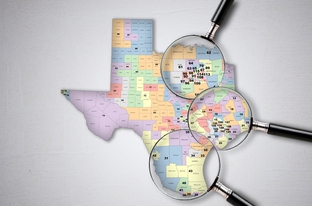An Eye on the Calendar

The state probably won't have political maps for federal and state legislators until November and possibly December, crowding the filing-fundraising-campaigning cycle into the holidays and perilously close to the March primaries.
Meanwhile, the U.S. Department of Justice named the districts it considers legally troublesome, and the Washington DC court hearing part of the redistricting arguments set some deadlines that put the case on the calendar.
Where things stand:
• The DOJ says five state House districts are problematic when it comes to Section 5 of the federal Voting Rights Act: HD-33, an open seat in Rockwall and Collin counties; HD-35, a South Texas seat currently held by Rep. Jose Aliseda, R-Beeville; HD-41, the Hidalgo County district where Rep. Aaron Peña, R-Edinburg, is the incumbent; HD-117, a San Antonio district represented by Republican John Garza; and HD-149, the Houston district where Democratic Reps. Hubert Vo and Scott Hochberg are paired. "The United States contends that the proposed House plan will not change the ability of any citizens, on account of race, color or membership in a language minority group, to elected their preferred candidates in any of the remaining 145 districts," DOJ's attorneys wrote. They're saying the state didn't diminish voting power in those districts, and that's the test for preclearance. They said the state went backwards — retrogressed — in four of the districts and that they're still studying the last one, HD-149.
• The Justice folks have reservations about two congressional districts: CD-23, the sprawling West Texas district represented by Francisco "Quico" Canseco, R-San Antonio; and CD-27, which runs from Corpus Christi to the Houston exurbs and north to the Austin suburbs and is represented by Blake Farenthold, R-Corpus Christi.
• The DC court gave preclearance to the State Board of Education map, meaning the state can use that one. Since the House, Senate and congressional maps haven't received preclearance, the judges in the San Antonio court say those maps can't be enacted yet.
• DOJ didn't find preclearance problems with the state Senate map, but that doesn't mean it's approved. In the San Antonio cases, opponents of that plan say it should have drawn more minority opportunity districts — places where minority voters have the ability to elect the candidate of their choice — and won't be legal until it does.
The timetable for the new maps is dependent on the courts. The San Antonio court has already held some hearings but hasn't ruled, and has hearings on the Senate map starting Nov. 14. The DC court will start its preclearance hearings on Nov. 2.
Unless something changes, candidates have to file for office between Nov. 12 and Dec. 12, but that's impossible if no maps have been approved by the courts. With that in mind, some of the lawyers have asked the San Antonio judges to be ready to draw contingent maps that can be used for next year's elections if the DC court hasn't finished its work. That's happened before — it would mean running an election under a new court-drawn map and then revising it for later elections depending on how the courts rule on the maps drawn by the Legislature.
If that makes your head sore, imagine what it's like for candidates who really aren't sure where their voters are. They won't be, either, until the courts do something.

